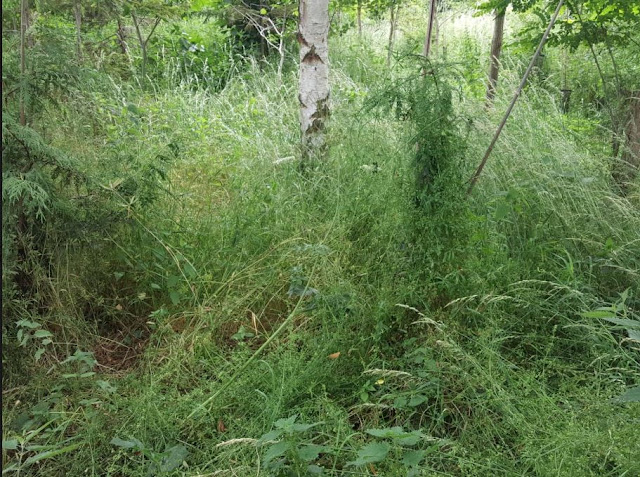Weeding.
When seeds are germinating on a woodland floor they need to compete with not only other seeds but also the plants that are already there. Tree seedlings tend to grow more slowly than herbaceous plants and get swamped. When trees are being planted they are usually at least 12" tall they are also normally planted into soil that has been sprayed with herbicide or ploughed. I usually spot spray the places where new trees are to be planted. Spraying again in the late spring after planting if possible. The idea being to reduce competition for water and nutrients.
 |
| Spot spraying of newly planted trees at Pit Wood. An almost ideal mown flat grass meadow. Planting into a woodland presents different problems. |
The problems associated with mature weed beds is the competition for light from tall perennial weeds and shrubs.
 |
| The Goose Grass swamping the Coast Redwood in front of the Birch tree will have to be removed by hand. |
Once the trees are established I try to keep about one in three rows reasonably clear of weeds to make access easier. This is done by brush cutting and spraying. If there are not pressing reasons to get down between the trees This may not happen with the result that moving through the wood can become very difficult.
I received a pleasant surprise while collecting old spirals in Cairn Wood. The photograph is of a Bee Orchid. To find it was a real shock. It was in a very heavily shaded area and they are flowers of open dry limestone grassland. The heavy clay at Cairn wood was arable before being willow coppice. I will certainly have sprayed the whole field with Glyphosate twice while getting rid of the Willow. There is unlikely to be a Bee Orchid within several miles, so how and why it is here is a complete mystery. I have pruned back the dense shade around it to give it a chance. It is not normal for me to try to favour plants of no apparent use. It is of little environmental value as the bee it mimics is not in the country, so has to be self pollinating. I will be careful and watchful with weed control now.






